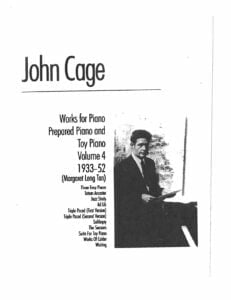Browse in the Library:
John Cage: the 100 most inspiring musicians of all time
Music of the mid-20th century was profoundly influenced by the inventive compositions and unorthodox ideas of American avant-garde composer John Milton Cage, Jr. (b. Sept. 5, 1912, Los Angeles, Calif., U.S.—d. Aug. 12, 1992, New York, N.Y.).
The son of an inventor, Cage briefly attended Pomona College and then traveled in Europe for a time. Returning to the United States in 1931, he studied music with Richard Buhlig, Arnold Schoenberg, Adolph Weiss, and Henry Cowell. While teaching in Seattle (1936–38), he began organizing
percussion ensembles to perform his compositions, and he began experimenting with works for dance in collaboration with his longtime friend, the choreographer and dancer Merce Cunningham.
Cage’s early compositions were written in the 12-tone method of his teacher Schoenberg, but by 1939 he had begun to experiment with increasingly unorthodox instruments such as the “prepared piano” (a piano modified by objects placed between its strings in order to produce
percussive and otherworldly sound effects).
John Cage also experimented with tape recorders, record players, and radios in his effort to step outside the bounds of conventional Western music and its concepts of meaningful sound. The concert he gave with his percussion ensemble at the Museum of Modern Art in New York City in 1943 marked the first step in his emergence as a leader of the American musical avant-garde.
In the following years, Cage turned to Zen Buddhism and other Eastern philosophies, concluding that all the activities that make up music must be seen as part of a single natural process. He came to regard all kinds of sounds as potentially musical, and he encouraged audiences to take note of all sonic phenomena, rather than only those elements selected by a composer. To this end he cultivated the principle of indeterminism in his music.
He used a number of devices to ensure randomness and thus eliminate any element of personal taste on the part of the performer: unspecified instruments and numbers of performers, freedom of duration of sounds and entire pieces, inexact notation, and sequences of events determined by random means such as by consultation with the Chinese Yijing (I Ching).
In his later works he extended these freedoms over other media, so that a performance of HPSCHD (completed 1969) might include a light show, slide projections, and costumed performers, as well as the 7 harpsichord
soloists and 51 tape machines for which it was scored. Among Cage’s best-known works are 4’33” (Four Minutes and Thirty-three Seconds, 1952), a piece in which the performer or performers remain utterly silent onstage for that amount of time (although the amount of time is left to the determination of the performer);
Imaginary Landscape No. 4 (1951), for 12 randomly tuned radios, 24 performers, and conductor; the Sonatas and Interludes (1946–48) for prepared piano; Fontana Mix (1958), a piece based on a series of programmed transparent cards that, when superimposed, give a graph for the random selection of electronic sounds; Cheap Imitation (1969), an “impression” of the music of Erik Satie; and Roaratorio (1979), an electronic composition utilizing thousands of words found in James Joyce’s novel Finnegans Wake.
Cage published several books, including Silence (1961) and M: Writings ’67–’72 (1973). His influence extended to such established composers as Earle Brown, Lejaren Hiller, Morton Feldman, and Christian Wolff.

Best site for sheet music download is here.
John Cage: Piano Works (Full Album)
Track List:
00:00:00 Three Easy Pieces (1933): Round 00:01:54 Three Easy Pieces (1933): Duo 00:02:36 Three Easy Pieces (1933): infinite CaNon 00:03:11 Three Easy Pieces (1933): Quest 00:04:01 Metamorphosis (1938): Metamorphosis I 00:06:17 Metamorphosis (1938): Metamorphosis II 00:08:54 Metamorphosis (1938): Metamorphosis III
00:13:59 Metamorphosis (1938): Metamorphosis IV 00:15:13 Metamorphosis (1938): Metamorphosis V 00:17:43 Jazz study (1942) 00:20:20 Tripled paced (first version, 1943): Tripled paced – 1a versione I
00:21:16 Tripled paced (first version, 1943): Tripled paced – 1a versione II 00:22:07 Tripled paced (first version, 1943): Tripled paced – 1a versione III 00:22:43 Ad lib 00:25:46 Soliloquy 00:28:21 Ophelia 00:34:45 Two pieces (1946): Two pieces I 00:38:22 Two pieces (1946): Two pieces II 00:42:07 in A landscape 00:50:08 Dream 00:56:24 Suite for toy Piano – versione per Pianoforte – I 00:57:42 Suite for toy Piano – versione per Pianoforte – II 00:59:09 Suite for toy Piano – versione per Pianoforte – III
01:00:20 Suite for toy Piano – versione per Pianoforte – IV 01:01:52 Suite for toy Piano – versione per Pianoforte – V 01:02:47 Seven Haiku I 01:03:00 Seven Haiku II 01:03:11 Seven Haiku III 01:03:34 Seven Haiku IV 01:03:50 Seven Haiku V 01:04:14 Seven Haiku vi 01:04:32 Seven Haiku viI 01:04:52 For M.C. and D.T. 01:05:40 Waiting 01:09:21 Socrate (1918) Drame symphonique en trois parties Transcription for two pianos by Cage (1944–1968): I Portrait de Socrate (Le Banquet)
01:15:47 Socrate (1918) Drame symphonique en trois parties Transcription for two pianos by Cage (1944–1968): II Bords de l’Iliussus (Phèdre) 01:22:39 Socrate (1918) Drame symphonique en trois parties Transcription for two pianos by Cage (1944–1968): III Morte de Socrate (Phédon) 01:38:23 Cheap imitation (1969) I 01:44:26 Cheap imitation (1969) II 01:53:28 Cheap imitation (1969) III 02:09:39 Etudes Boreales I (Piano) 02:15:13 Etudes Boreales II (Piano)
02:20:44 Etudes Boreales III (Piano) 02:26:22 Etudes Boreales IV (Piano) 02:32:04 Etudes Boreales I (cello) 02:37:32 Etudes Boreales II (cello) 02:43:12 Etudes Boreales III (cello) 02:48:41 Etudes Boreales IV (cello) 02:54:22 Etudes Boreales I (cello & Piano) 03:00:07 Etudes Boreales II (cello & Piano) 03:05:51 Etudes Boreales III (cello & Piano) 03:11:30 Etudes Boreales IV (cello & Piano)
